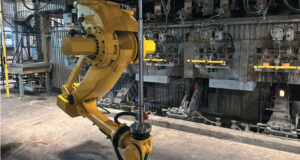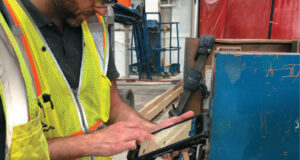
Pulp and paper manufacturing is one of the largest industries in the world, and it can also be one of the most dangerous as its workers face a multitude of health risks in their day-to-day jobs. Personnel at paper mills can be subject to various health hazards, including toxic chemical substances; fires or explosions caused by highly combustible paper dust; or injuries associated with large mechanical equipment, sharp surfaces, and confined spaces.
As one of the leading industries in the US, it is essential for paper making and converting facilities to have comprehensive safety plans that follow certain safety standards and regulations. While personal protective equipment (PPE) such as high visibility reflective vests, hard hats, and safety glasses are required on the jobsite, there is a growing need to digitize the pulp and paper industry to further enhance workplace safety and mitigate risk.
Using new AI-driven tech, connected worker solutions—such as real-time location systems (RTLS)—offer improved worker safety and monitoring within dangerous manufacturing fields. These solutions give managers key digital data about their workers and assets and can be critical in the transformation of workplace safety and management.
In the case of emergency situations, such as fires or chemical spills, knowing the exact location of employees and contractors on a jobsite is critical. RTLS can not only pinpoint personnel in real time, but also reduce costly time delays for emergency responders.
Digitalization is not unique to the pulp and paper field. The ability to remotely monitor the wellbeing of workers offers a smart, digital way to know who is on the job, what they’re doing, and if they’re doing it safely.
TRADITIONAL VS AUTOMATED
Typically, disparate systems and manual processes have challenged real-time access to information on workers and other key assets. Physical paperwork can lead to fragmented and incomplete data, while individual headcounts can be time-consuming and subject to human error. And in the event of an emergency, time is of the essence.
Real-time location systems allow administrators to improve their overall operational safety and keep tabs on employees. As digital transformation accelerates throughout the manufacturing space, RTLS and its associated data will be an integral part of the Industry 4.0 ecosystem.
HOW DIGITIZED SAFETY WORKS
RTLS are designed to monitor the exact whereabouts of people or objects within an allocated area.
The systems typically consist of combined hardware, such as a wireless tag either attached to objects or worn by employees, and software that communicates to provide accurate and updated location information on all tagged assets.
Many types of wireless tag tracking technologies are available, including Radio-Frequency Identifications (RFID) Tags and Global Navigation Satellite System (GNSS) Tags. Depending on the RTLS capabilities, managers can assign specific tag codes to help further distinguish employees or contractors.
A unified system infrastructure that offers plant-wide visualization can increase insights into a mill or plant’s operations; by using technology to identify the accurate location of a person or an asset within a worksite, users can improve overall workplace safety, security, and productivity.
HONEYWELL AND RTLS
For many companies, their distributed workforce can be spread across large areas, resulting in periods of time where mobile and lone workers can be unaccounted for. Aside from security concerns, other operational issues can arise, such as excess work hour billing or unproductive time delays. With real time visibility, companies can verify an employee’s specific location, improve search and rescue, and calculate time onsite to avoid overbilling.
To address these concerns, Honeywell created Safety Watch as a way to increase worker safety and security while helping improve overall operational efficiency. Designed to enhance the safety of workers and contractors across numerous industries, this solution is made for the most hazardous locations and meets industry standards for safety zones.
Using the ISA100 Industrial Wireless Standard, Safety Watch wirelessly connects to one or more receivers set up around the plant and sends real-time location data to a Safety Watch administrator via the Safety Watch Dashboard.
Location accuracy is achieved based on receiver installation. One receiver can identify the number of active Safety Watch devices within a radius of 492 feet; with three on-site receivers, Safety Watch can triangulate a wearer’s location and provide an accurate reading within 10 to 16 feet.
The device monitors an employee’s location and delivers instant alerts and notifications if workers are in an area that requires specific safety training or security clearance, or if a worker has exceeded the time allowed to be in such a location. In fact, results have shown that Safety Watch can reduce mustering time by 80 percent—from hours to minutes—compared to manual approaches, while enabling faster search and rescue operations during emergency situations.
The device is also equipped with a physical SOS button that wearers can push in a crisis. Additional features include “last known location” that will allow administrators to track the last location of workers in case of a major event, and a “person-down” technology that immediately sends an alert to the user dashboard if any employee has experienced a fall or shows no movement for a predetermined period of time. This allows help to reach the injured faster and provide medical assistance as needed.
Beyond improving workplace safety, Safety Watch can also advance worker safety and policy compliance.
EMPLOYEE MANAGEMENT
Real-time locational data is crucial during any emergency situation, but the information can also be used to ensure worker security and wellbeing as well as encourage policy compliance.
Safety Watch operators can ensure that hazardous or dangerous areas are restricted from access and that protocols onsite are followed. For example, if there is a specific zone that certain personnel, contractors, or visitors are unauthorized to enter, administrators can create a “geo-fence”—a virtual perimeter for a geographic area—and be notified if there is a breach.
Additionally, geo-fencing technology can be used to establish trails and walk paths to enhance safety and track compliance. The same type of geo-fencing can be applied to create automatic sign in/out at access points to account for all workers entering and leaving the site, eliminating the need for manual head counts and reducing movement bottlenecks.
Safety Watch also includes fatigue management features that provide real-time monitoring and enable supervisors to track if a worker did not remain in the rest area long enough or if workers have exceeded the duration of their work shift. Through these capabilities, Safety Watch helps monitor the health and safety of personnel while ensuring their effectiveness in the field.
The device tracks other important key performance indicators (KPIs) such as productivity of the business and incidents at a plant. Using alarm history, managers can track where workers are visiting the most and which areas require restricted access. Safety Watch also allows users to download reports based on contractors, incident reports, and past location data; with this in hand, managers can tailor safety training outlines and create learnings from the “do’s and don’ts” to improve training modules.
Real-time location systems are one way paper mills can help improve worker safety, security, wellbeing, and overall productivity. Other traditional tools like PPE are still essential; however, by integrating remote autonomous technology, users can improve worker safety and day-to-day management style, ultimately helping minimize serious or even fatal accidents and creating a safer work environment.
 Paper 360
Paper 360

